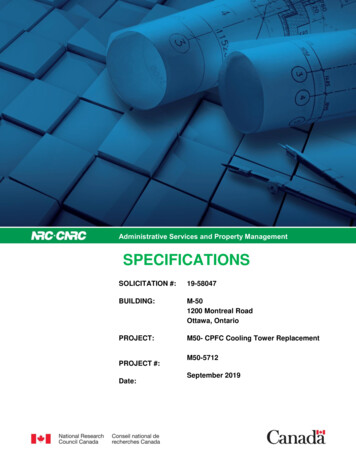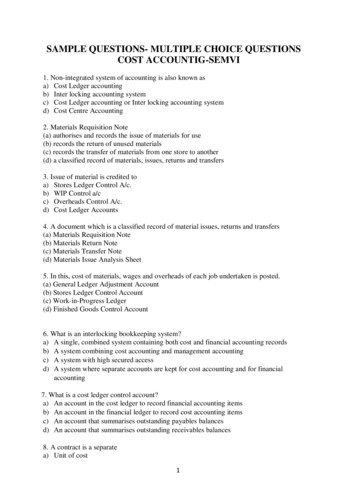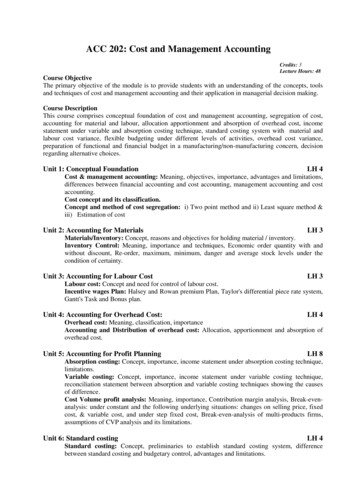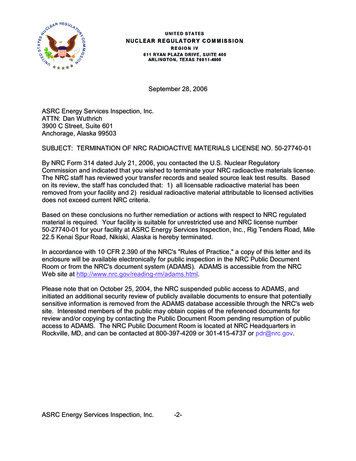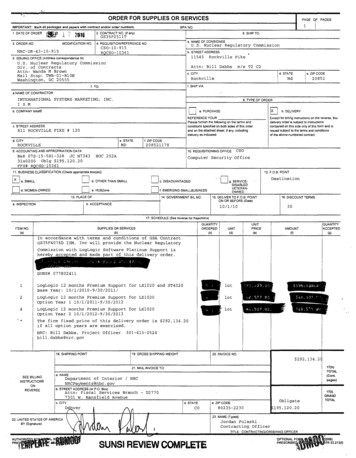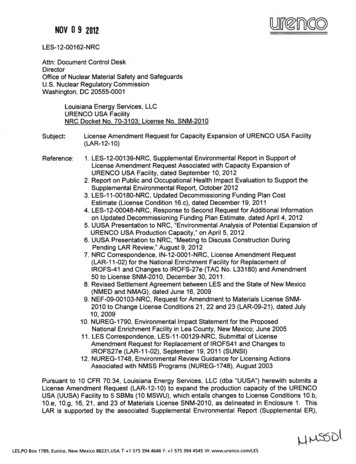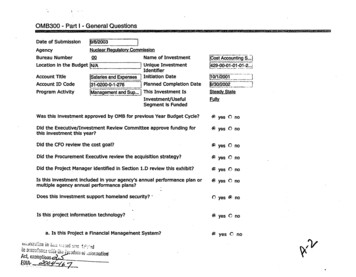
Transcription
OMB300 - Part I - General QuestionsDate of Submission23AgencyNuclear Regulatory CommissionBureau Number00Name of InvestmentLocation In the Budget LiUnique Investment/]LCost Accounting42900 01s.j01012. .Identifierand Expense!esAccount TitleAccount ID Code31-0200-0-1-276Program ActivitygInitiation DatePlanned Completion DateThis Investment IsInvestment/Useful0I1 12001 19/30/2002JrSteady StateFullySegment Is FundedWas this Investment approved by OMB for previous Year Budget Cycle?r- yes 0 noDid the Executive/Investment Review Committee approve funding forthis Investment, this year?(7Did the CFO review the cost goal?Oe yes 0 noDid the Procurement Executive review the acquisition strategy?(* yes 0 noDid the Project Manager Identified in Section 1.D review this exhibit?ES yes 0 noIs this Investment Included In your agency's annual performance plan ormultiple agency annual performance plans?(3 yes 0 noDoes this Investment support homeland security? -0 yes O noIs this project information technology?F'a. Is this Project a Financial Management System?icn eCornl3U' s 5" ; eadEOAOor;-tationryes 0 noyes C no; yes C no.IV'
Is so, does this project address a FFMIA compliance area?If yes, which compliance area?[FFAS0) yes Ci noNo.10b. Does this project Implement electronic transactions or recordkeeping that is covered by the Government Paperwork EliminationAct (GPEA)?0 yes fi noDoes the project already provide an electronic option?Ci yes ( noc. If the Investment administers Information in Identifiable form about re) yes r, nomembers of the public, was a privacy Impact assessment submittedvia PIA omb.eop.gov with a unique project (investment) Identifier?d. Was this Investment reviewed as part of the FY 2003 FederalR yes C noInformation Security Management Act review process?d.1 If yes, were any weaknesses found?e. Has this investment been identified as a national critical operationor asset by a Project Matrix review or other agency determination?C yes 07 no0 yes M noe.1 If no, Is this an agency mission critical or essential service,system, operation, or asset (such as those documented In theagency's COOP Plan), other than those Identified as above asnational critical Infrastructures?C yes 60 nof. Was this investment Included in a Performance Assessment RatingTool(PART) Review?0 yes 0) noOMB300 - Part I - Summary of Spending for Project (Investment) Stages(InMillions)
--OutlaysAcquisition:Budgetary ResourcesOutlays02TOTAL, Sum of Stages:Budgetary ResourcesOutlaysMaintenance:Budgetary Resourcesr d-Outlays1§1 L7]Il. .llTOTAL, ALL Stages:lti-----III t0 13A,.ABudgetary ResourcesOutlaysfiIAi-ieal 1*Government FTE Costs:OMB300 - Part II1.1-VJVlc:L 1VC;;:%A1l1%JIII1. Provide a brief description of this project and Its status through your capital planning andinvestment control (CPIC) or capital programming "control" review for the current cycle.fThis project was submitted in prior fiscal years as part of the Starfire Agency-wide Financialland Resource Management System and as part of the Human Resource Management System(HRMS). The Starfire Agency-wide system was downsized, and we are now focusing onindividual components of the original project.6The chart below displays the components of the Initial concept of Starfire, the components ofiof HRMS and the current spilt of the Cost Accounting system from HRMS.IStarfire (Initial Concept) included:YHumanResourcesTime and LaborIPayrolli
Cost AccountingTravel ManagementCore AccountingDebt ManagementFee BillingBudget FormulationProcurementPropertyHRMS (Last Year) Included:Human ResourcesTime and LaborPayrollCost Accountingravel ManagementCurrent StatusHRMS - Human ResourcesHRMS- Time and LaborHRMS - PayrollCost Accounting (Separate System)In prior fiscal years, the ImplementatIon of the cost accounting system was a key componentto completing a remedlation plan to Implement Statement of Federal Financial AccountingStandards (SFFAS) No. 4, Managerial Cost Accounting Concepts and Standards for the FederalGovernment. The system was certified for operation during the fourth quarter of FY 2002.Two Capital Planning and Investment Control business cases were performed in the originalplanning for Starfire. They Included a life-cycle cost analysis and a benefits/costs analysis.The initial analysis encompassed the core accounting system and its related financial/resourcesystems. This analysis was later supplemented with a review of the costs and benefitsrelated to the essential basic human resources system component needed to support theachievement of HRMS and cost accounting's complete functional objectives (namely, laborcost distribution and cost accounting). In both Instances, alternatives (including Status Quo)were Identified and a cost benefit analysis was performed, resulting In NRC selecting not onlythe lowest cost alternatives, but also those which were expected to deliver the most benefitto the agency In a timely manner.StatusCost Accounting system steady state: The cost accounting system enables the NRC to
assign and allocate 'costs, trace allocation paths, and provide multidimensional analysis. Theisystem provides managers with cost data to assist them In evaluating the performance of their programs, to capture full cost of software development projects, and to produce reportsffor use In the compilation of the agency quarterly financial statements. The cost accountings system uses computer off-the-shelf (COTS) software products; Microsoft jAccess, Armnstrong-Laing Metify Activity BasedManagement, and COGNOS Reporting.2. What assumptions are made about thisjp roject and why)?.Tecost accounting system will continue to utilize the agency's existing hardware andsoftware Infrastructure and other new capabilities as they are made available, such asdocument and workfi'ow processing.IThe cost accounting system has been customized only to meet Federal regulations or specificrequremnts pprvedor requested by NRC senior management.Theostaccuntng ystm Interfaces with HRMS for labor hours and Interfaces with thejagncycor acouningsystem for cost data. At this time, the NRC will continue to maintain the existing COTS products of the costaccounting system by utilizing patches, fixes, and software updates as they are Issued by thesoftware vendors.lCost Assumptions Include:jCost estimates for SY 4 and beyond are 0.7 million per year and run through FY 2011. Beginning with this reporting, FTEs converted to dollars are Included In the figures shown forIFY 02 forward In the budgetary resources and outlays. Aa 6/28/02 meeting, 0MB gave OCIO the following guidance for estimating resources: If a person spends 50% or more of their time on the IT project, round up to 1.0 FTE. The HRMS/ Cost Accounting sponsor concluded that rounding to full FTEs would Inflate the number'of resources assigned to this project. Therefore, the FTE estimates for Cost Accounting reflectla summation of partial FrEs.iIT Security costs allocation Included: FY03- 70K, FY04- 70K, FY05- 70I ss Estimated Represent estimated useful life to FY 2012.3. ProvIde any other supporting Information derived from research, Interviews, and otherdocumentation.---------
No other supporting documentation Is required.OMB300 - Part I - LB Justification1. How does this Investment support your agency's mission and strategic goals and objectives?The cost accounting system supports the agency mission and goals by making availabletimely human capital and cost information to NRC managers to help them evaluate NRCprogram performance. The cost accounting system also generates reports displaying the fullcost of agency outputs that sum to responsibility segments for use In the compilation of thequarterly Statement of Net Cost financial statement which allows the agency to meet theaccelerated financial reporting requirements mandated by OMB. Last, management plans toassess the potential for using the cost accounting system to provide data to measure andreport to OMB and Congress the performance of agency programs and strategic goals inaccordance with the Government Performance and Results Act (GPRA) of 1993.Maintaining the cost accounting system ensures that we continue to support the agency'smission, strategic goals and objectives, and critical business processes In an efficient andeffective manner that Is consistent with the President's Management Agenda and governmentwide Initiatives.NRC Mission: To regulate the Nation's civilian use of byproduct, source, and special nuclearmaterials to ensure adequate protection of the public health and safety, to promote thecommon defense and security, and to protect the environment.GOALNRC Corporate Management Strategy 1: Employ Innovative and sound business practicesiSTRATEGIESWe will strengthen collaborative processes for conducting business among support officesand between support and program offices.We will find new and better ways of doing business to increase the effectiveness andefficiency of operations.We will create and maintain a planning, budgeting, and performance management processthat is focused on outcomes and provides and effective tool for setting goals, allocatingresources, tracking progress, measuring results, and Identifying areas for Improvement.
SUPPORTThe cost accounting system produces reports to meet the cost accounting standards of SFFASinternal use software capitalization requirements of SFFAS #10, and financial statementI4,reporting requirements contained In OMB Bulletin 01-09.6OALNRC Corporate Management Strategy 3: Provide proactive information management andinformation technology services.STRATEGIESWe will work jointly with program and support offices to Integrate Information technology andbusiness planning as a means of achieving agency goals and strategies.LWewill make It easier for the staff to acquire, access, and use the Information they need toperform their work.We will Improve the ability of the NRC and external entitles to conduct our mutual businesselectronically.SUPPORTOur financial management systems will be maintained and updated on a regular basis so thatwe can continue to provide human resources, financial, managerial cost, and performanceiata in a timely and efficient manner.We will seek to Incorporate Input from program and support partners, as we develop anagency plan to provide and sustain an accurate level of detailed cost data. The maintenanceDf the cost accounting system will assist the agency in continuing to meet Its reporting andFiduciary responsibilities In an increasingly demanding and changing technologicalenvironment.2. How does Is support the strategic goals from the President's Management Agenda?PMA GOAL - Financial PerformanceSUPPORT - The cost accounting system provides financial performance Information for agencyprograms and generates reports for the compilation of the quarterly financial statement.
IPMA GOAL - E-Government'SUPPORT - The cost accounting system supports the President's Initiative to "automateinternal processes to reduce costs internally" by making the production of cost accountingInformation more efficient through the use of technology. This information is used to helpmanagers make Informed decisions, and as an Input to the preparation of the Statement ofNet Cost.PMA GOAL - Budget and Performance IntegrationSUPPORT - The cost accounting system provides support to NRC managers and staffmanaging agency programs consistent with the NRC Strategic and Performance Plans. Costaccounting Information supports the agency's corporate management strategy (PerformancePlan) to employ Innovative and sound business practices by strengthening "our financialsystems and processes to ensure that our financial assets are adequately protected consistentwith risk and that our financial Information is better integrated with decision-making." Thisstrategy underlies the performance goals to make the NRC activities and decisions moreefficient and effective, and to increase publc confidencec3. Are there any alternative sources In the public or private sectors that could perform thisfunction?5. Who are the customers for this project?The customers are NRC employees and managers.6. Who are the stakeholders of this project?The stakeholders of the cost accounting system are listed below and have been defined bytheir Input or receipt of Information.kInternaljy of NRCI*Employees
ManagersOffice of Chief Financial Officer, Including Time & Labor reporting, accounting, budget, and feebilling functionsOffice of Chief Information OfficerExternallyOffice of Management and Budget (CFO Financial Statements)U.S. Congress (CFO Financial Statements)U.S. Department of Treasury (CFO Financial Statements)Other Readers of the CFO Financial Statements7. If this is a multi-agency initiative, Identify the agencies and organizations affected by thisinitiative.his Is not a multi-agency initiative.7.a If this is a multi-agency Initiative, discuss the partnering strategies you are Implementingwith the participating agencies and organizations.rhis Is not a multi-agency Initiative.8. How will Investment reduce costs or Improve efficiencies?The purpose of the system Is to provide timely and relevant cost Information to decisionmakers so that they can make more Informed financial decisions. The system makesipreparation of cost accounting reports more efficient through automation, and providessignificant timeliness Improvements over labor-intensive manual processes.Cost accounting steady state:Prior to the current cost accounting system, cost analysis Involved considerable effort Inextracting information from various sources and there was no consistency In how suchanalysis was done. During the acquisition and development of the cost accounting system,the NRC followed a best-practices approach utilizing COTS software with minimalcustomization. The result Is a cost accounting system that relies on a single point of entry forcapturing data and managers are now provided with consistent and reliable cost data on aperiodic basis.iEfficiencles were realized as a significant level of manual effort was eliminated by the
implementation of an automated tool to gather and manipulate large volumes of data. The,NRC anticipates additional cost savings as managers realize the potential for using cost data1to evaluate and improve program performance.9. List all other assets that Interface with this asset.CAS interfaces with the Human Resources Management System and the core financial accounting system.*C yes (i no9.a Have these assets been reengineered as part of this project?OMB300 - Part I - I.C Performance Goals and Measures (All Assets)Agencies must use Table 1 below for reporting performance goals and measures for existinginvestments that were Initiated prior to FY 2005. The table can be extended to Includemeasures for years beyond FY 2004.Table 1 (projects through 2004)Fiscal YearStrategic Goal(s) SupportedNRC Corporate Management Strategy 1: Employ innovative and sound business practicesExisting BaselineO% current with updatesand time and labor reporting.I In compliance with federal regulations and poliies on payrollPlanned Performance Improvement GoalM'aMaintain current updates to ensure compliance with federal regulations and policies.Actual Performance Improvement Results
lCurrent with updates and In compliance with federal regulations and policies.Planned Performance Metric1100% current with updates and in compliance with federal regulations and policies on payroll];and time and labor reporting.Actual Performance Metric Results100% current with updates and in compliance with federal regulations and policies on payrolland time and labor reporting.[004iFiscal YearStrategic Goal(s) SupportedFNRC Corporate Management Strategy 1: Employ Innovative and sound business practicesExisting Baseline1100% current with updates and in compliance with federal regulations and policies on payrollland time and labor reporting.Planned Performance Improvement Goal{Maintain current updates to ensure compliance with federal regulations and policies.Actual Performance Improvement ResultsTo be determined in FY2004. .om .i.Planned Performance Metric1100% current with updates and In compliance with federal regulations and policies on payroll I.
land time and labor reportIng.Actual Performance Metric ResultsTo be determined In FY 2004Fiscal YearF? 0 9 L-- -- - i--Strategic Goat(s) SupportedjNRC Corporate Management Strategy 1: Employ Innovative and sound business practicesIExisting Baseline1000/ current with updates and in compliance with federal regulations and policies on payrolland time and labor reporting.)lanned Performance Improvement Goalnitai n current'update to ensure compliance with federal regulations and policies.Actual Performance Im provem ent ResultsFfobe determined In FY20051Planned Performance Metric1000/ current with updates and In compliance with federal regulations and policies on payrolland time and labor reporting.Actual Performance Metric Results,---Irbdetermined in FY 2005I
Fiscal YearStrategic Goal(s) Supported,1NRC Corporate Management Strategy 1: Employ Innovative and sound business practicesExisting Baseline'Published the FY 2001 financial statement and received an unqualified opinion.Planned Performance Improvement Goal Mitin quality of Input for the agency's annual financial statement.Actual Performance Improvement Results[Published the FY 2002 statement and received an unqualified opinion.Planned Performanc'e MetricIMaIntain status of unqualified opinion for FY statements.Actual Performance Metric ResultsjPublished the FY 2Q02 statement and received an unqualified opinion.Fiscal YearStrategic Goal(s) Supported12004
INRC Corporate Management Strategy 1: Employ innovative and sound business practicesExisting Baseline Published the FY 2001 financial statement and received an unqualified opinion.Planned Performance Improvement GoalNMalntaln quality of Input for the agency's annual financial statement. .i .A.Actual Performance Improvement Resultst To be determined after FY 2003 audit.Planned Performance MetricMaintain status of unqualified opinion for FY statements.Actual Performance Metric ResultsjTo be determined after FY 2003 audit.Fiscal YearStrategicCoManaemeStagIINRC Corporate Management Strategy 1: Employ innovative and sound business practicesExisting Baseline.
Published the FY 2001 financial statement and received an unqualified opinion.Planned Performance Improvement Goal[Maintain quallty of input for the agency's annual financial statement.Actual Performance Improvement Results'To be determined after FY 2004 audit.Planned Performance Metricaintain status of unqualified opinion for FY statements.Actual Performance Metric ResultsITo be determined after FY 2004 audit.Fiscal Year[2004Strategic Goal(s) SupportedINRC Corporate Management Strategy 3: Provide proactive information management andinformation technology services.Existing Baseline(New goal- customer satisfaction baseline to be established In FY04)n .I.m.eP rPlanned Performance Improvement Goal
Improve user/customer satisfaction for cost accounting.Actual Performance Improvement Results1ilbe realized next year. ---Planned Performance Metric!Improve usability by eliminating deficiencies cited In past Information systems surveys.'Level of satisfaction to be measured with customer survey.Actual Performance Metric Results[Wii be realized next year.[2oo5Fiscal YearStrategic Goal(s) Supported[NRC Corporate Management Strategy 3: Provide proactive information management andInformation technology services.Existing Baseline (New goal- customer satisfaction baseline to be established In FY04)Planned Performance Improvement GoalImprove user/customer satisfaction for cost accounting.Actual Performance Improvement ResultsFo be measured in FY05
Planned Performance MetricjImprove usability by eliminating deficiencies cited In past Information systems surveys.iLevel of satisfaction to be measured with customer survey.Actual Performance Metric ResultsTo be measured in FY05Fiscal YearStrategic Goal(s) SupportedNRC Corporate Management Strategy 3: Provide proactive Information management nin fo'r m"a-t-Ion -tech-n-ology ser v Ices.)Quarterly cost accounting reports are being distributed to NRC managers.iPlanned Performance Improvement Goalmprove access by agency program managers to current financial and performanceinformation.Actual Performance Imp1rovemenRt ResultsIWill berealized next year.Planned Performance MetricNumber of program managers able to obtain financial and performance data and utilizing ItIfor day-to-day decision-making.
Actual Performance Metric Results1W Illi:-e-eaizd-ex-yarFiscal YearI Strategic Goal(s) Supportedo ---NRC Corporate Management Strategy 3: Provide proactive Information management andinformation technology services.Existing Baselinel urtelycost accounting reports are being distributed to NRC managers.PlannedPerformance Improvement Goal Improve access by agency program managers to current financial and performanceinformation.ZActualPerformance Improvement Resultsbe measured In FY05roPlanned Performance MetriciNumber of program managers able to obtain financial and performance data and utilizing It1for day-to-day decision-making.Actual Performance Metric Results-ITo be measured In FY05
All new IT Investments that are development, modernization, or enhancement (DME) for 2005and beyond must use Table 2 and are required to use the FEA Performance Reference Model.The PRM Version 1.0, available at www.feapmo.gov. Includes detailed guidance about how toincorporate PRM Indicators Into the performance goals and measures table below. Please usethe Table 2 and the PRM to identify the performance Information that pertains to the major ITInvestment. Ensure there is a complete tie-In to the strategic goals and objectives describedIn section I.B.1.Table 2 (2005 and beyond)OMB300 - Part I - I.D Project Management1. Is there a project manager assigned to the project?Ii yes 0 noIf so what Is the project manager's name:Gordon S. Peterson1.a Identify the members, roles, qualifications, and contact information of the in-house andcontract project managers for this project:The program manager is Gordon Peterson, Cost Analysis Team Leader, Office of the ChiefFinancial Officer, (301) 415 - 7348.Mr. Petersonws experience and qualifications Include extended financial management andsystems Implementation experience. He also has assisted in writing Federal AccountingStandards as a staff member with the Federal Accounting Standards Advisory Board.2. Is there a contracting officer assigned to the project?If so what is the contracting officer's name:lGeorge M. Mathews III, Technical Manager and Contracting Off.l3. Is there an Integrated project team?3.a If so, list the skill set represented.IThis project team Includes:-st.yes C noA yes C no
//JI,IOMB300 - Part 11- II.A Enterprise ArchitectureI.A.1 BusinessA. Is this investment identified In your agency's enterprise architecture? If not, why?IYes, the cost accounting system has been Identified In the NRC approved enterprise architectureI(EA).A.1 Will this Investment be consistent with your agency's "to be" modernization blueprint?The Cost Accounting System falls within the scope of the NRC baseline and target architecturesand Is consistent with the NRC "to be" modernization blueprint as defined in current NRC EAtechnology planning documents. NRC's current EA technology planning documents and coretechnology needs are In the process of being updated to align with the. FEA and expandedthrough an evolving organizational EA governance process to ensure that all current and future:technology needs are vetted by NRC business managers to validate links to NRC businessdrivers and business performance.ISince its inception, compliance with the EA In Its various Iterations has been given priority
consideration and has helped drive the technical requirements of cost accounting. The NRC ITechnical Reference Model (TRM) was provided to potential software vendors during the Initial isoftware solicitation phase of the project. Products not adhering to the TRM were appropriately Inoted and costed-out during the review of software proposals. Technical Interface requirementsare documented to detail Information on data that Is passed to the cost accounting system,Identify data edit requirements for completing the Interfaces and provide Information for errorreports. Other technical aspects, such as certifying Year-2000 compliance and having the abilityto run under the NRC existing and future operating systems were also carefully considered In theevaluation of proposals and products. "Portability" of data and Information to other COTSapplications throughout the NRC desktop computing environment was Included in the evaluationand this has been demonstrated with the modules we are currently implementing. This will help further ensure that unique office-specific data manipulation and reporting needs can be met withminimal software modification, thus enabling the cost accounting system to achieve anImportant deployment goal: minimize customization.The cost accounting software Is composed of COTS products. The cost accounting system isinterfaced with the NRC existing core accounting system (FFS) and existing time and laborystem (HRMS). The system Is designed to fit within the agency's client-server and LANinfrastructure and Is accessible via agency-standard microcomputer.B. Was this Investment approved through the EA Review committee at yourO yes C) noagency?;C. What are the major process simpiification/reengineering/design projects that are required aspart of this IT Investment?Cost Accounting Increases the automation and access of data, Improves operating efficiency, andprovides the agility and flexibility to adjust to and meet future business conditions anddemands. Cost accounting meets many of the elements of Federal mandates and businessdrivers, including- the Government Paperwork Elimination Act; the Government InformationSecurity Reform Act; the Clinger-Cohen Act; the Government Performance and Results Act; the1Privacy Act; and the E-government Act of 2002.D. What are the major organization restructuring, training, and change management projectsthat are required?As part of the implementation process, employees/users were trained In operating thelArmstrong-Laing Metify cost accounting and COGNOS reporting software packages. Newemployees/users of the cost accounting system are subsequently trained to use the software.E. Please list all the Lines of Business and Sub-Functions from the FEA Business Reference Modelthat this IT Investment supports.Line of BusinessSub-FunctionFinancial ManaaementIRecortna and Information1.I
RBudoetIIAccunin1Iand FinanceAssetandab1ity Manaaement'II'IU'II.A.2 DataA. What types of data will be used In thisInvestment? Examples of data types are health data,geospatlal data, natural resource data, etc.!The cost accounting system uses the following types of data:lContract costsLabor costsL1abor hours[Agency reporting structure dataB. Does the data needed for this Investment already exist at the Federal, State, or Local level? Ifso, what are you plans to gain access to that data?INo.The data in the cost accounting system Is generated from the NRC source systems as partof ongoing operations.C. Are there legal reasons why this data cannot be transferred? If so, what are they and did youaddress them In the barriers and risk sections above?No. The data In the cost accounting system Is generated from the NRC source systems as partlof ongoing operations.D. If this Initiative processes spatial data, Identify planned investments for spatial. data anddemonstrate how the agency ensures compliance with the Federal Geographic Data Committeestandards required by 0MB Circular A-16.lNo spatial data is maintained.E. If this activity involves the acquisition, handling or storage of Information that will bedisseminated to the public or used to support Information that will be disseminated to the public,explain how It will comply with your agency's Information Quality guidelines (Section 515requirements)?No data is disseminated to the public.I -.-.
F. Managing business information means maintaining Its authenticity, reliability, integrity, andusability and providing for its appropriate disposition. Address how the system will manage thebusiness information (records) that it will contain throughout the information life cycle. System records are maintained In a protective environment accessible only by authorized NRCstaff, or contractors, with proper access requirements. Additional protective measures areensured with an applicable system security plan. The electronic records are maintained on-linethroughout their entire life cycle, with system backups routinely created, in case of catastrophicloss. Cost data downloaded to the server (i.e., cost data and software copies) are stored offsite as is LAN cost files including the security plan.II.A.3 Application, Components and TechnologyA. Relation to Service Component Reference Model:Cost Accounting supports the multidimensional analysis of NRC cost data.JiService Domain:Service Type:Component Name:Is this a new component?Business Analytical ServicesAnalysis and StatisticsSelect.noService Domain:Service Type:Component Name:Is this a new component?Back Office ServicesFinancial ManagementSelect.no
A. Relation to Service Component Reference ModeCost Accounting supports the management of NRC.Service Domain:Service Type:Component Name:Is this a new component?. . . .,--.- -- .-Back Office ServiFinancial ManageSelect.noA. Relation to Service Component Reference Model:ICost Accountin
Cost Accounting (Separate System) In prior fiscal years, the ImplementatIon of the cost accounting system was a key component to completing a remedlation plan to Implement Statement of Federal Financial Accounting Standards (SFFAS) No. 4, Managerial Cost Accounting Concepts and Standards for the Federal Government.



